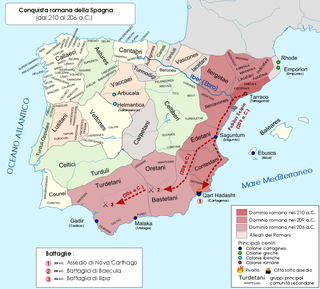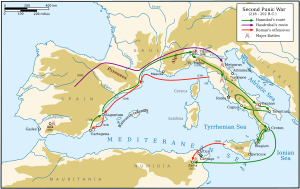Hamilcar Barca or Barcas was a Carthaginian general and statesman, leader of the Barcid family, and father of Hannibal, Hasdrubal and Mago. He was also father-in-law to Hasdrubal the Fair.
Gnaeus Cornelius Scipio Calvus was a Roman general and statesman during the third century BC. He played a major part in the Second Punic War, establishing Roman rule in the east of the Iberian peninsula and tying up several Carthaginian armies to keep them from reinforcing Hannibal.
Mago Barca was a Carthaginian, member of the Barcid family, who played an important role in the Second Punic War, leading forces of Carthage against the Roman Republic in Iberia and northern and central Italy. Mago was the third son of Hamilcar Barca, was the brother of Hannibal and Hasdrubal, and was the brother-in-law of Hasdrubal the Fair.

Hasdrubal Barca, a latinization of ʿAzrubaʿal son of Hamilcar Barca, was a Carthaginian general in the Second Punic War. He was the brother of Hannibal and Mago Barca.

The Battle of Ilipa was an engagement considered by many as Scipio Africanus’s most brilliant victory in his military career during the Second Punic War in 206 BC.

This is a historical timeline of Portugal.

The Battle of Baecula was a major field battle in Iberia during the Second Punic War. Roman Republican and Iberian auxiliary forces under the command of Scipio Africanus routed the Carthaginian army of Hasdrubal Barca.
The Battle of the Upper Baetis was a double battle, comprising the battles of Castulo and Ilorca, fought in 211 BC during the Second Punic War between a Carthaginian force led by Hasdrubal Barca and a Roman force led by Publius Cornelius Scipio and his brother Gnaeus. The immediate result was a Carthaginian victory in which both Roman brothers were killed. Before this defeat, the brothers had spent seven years campaigning against the Carthaginians in Hispania, thus limiting the resources available to Hannibal, who was simultaneously fighting the Romans in Italy.
Hanno was a Carthaginian general serving under Mago Barca in the Second Punic War. He is sometimes mistaken for Hanno, son of Bomilcar.
Hasdrubal Gisco, a latinization of the name ʿAzrubaʿal son of Gersakkun, was a Carthaginian general who fought against Rome in Iberia (Hispania) and North Africa during the Second Punic War.

The Battle of Decimomannu or Caralis took place in Sardinia when a Carthaginian army sailed to the island to support a local revolt against Roman rule. The army, led by Hasdrubal the Bald, fought a similar size Roman army under the Praetor Titus Manlius Torquatus in the Fall of 215 BC somewhere between Sestu and Decimomannu, just north of Caralis. The Romans destroyed the Carthaginian army and then scattered their fleet in a sea battle south of Sardinia.

The Roman Republic conquered and occupied territories in the Iberian Peninsula that were previously under the control of native Celtic, Iberian, Celtiberian and Aquitanian tribes and the Carthaginian Empire. The Carthaginian territories in the south and east of the peninsula were conquered in 206 BC during the Second Punic War. Control was gradually extended over most of the peninsula without annexations. It was completed after the end of the Roman Republic, by Augustus, the first Roman emperor, who annexed the whole of the peninsula to the Roman Empire in 19 BC.

Carthaginian Iberia was a province of the larger Carthaginian Empire. The Carthaginians conquered the Mediterranean part of Iberia and remained there until the 2nd Punic war and the Roman conquest of the peninsula.
This section of the timeline of Hispania concerns Spanish and Portuguese history events from the Carthaginian conquests to before the barbarian invasions.
The Battle of Carteia was a naval battle of the Second Punic War, fought between the navy of the Roman Republic and a Carthaginian fleet in 206 BC near the ancient city of Carteia in southern Spain. The Roman navy was commanded by Gaius Laelius and the Carthaginian navy by Adherbal. The battle resulted in a Roman victory.
Marcus Junius Silanus was one of the most successful Roman commanders in the Spanish theatre of the Second Punic War. He is best remembered for his defeat of Hanno and Mago in Celtiberia in 207 BC.
Larus was a leader of Cantabrian mercenaries in the Carthaginian army during the Second Punic War, according to Silius Italicus's poem Punica.

Mercenary life is recorded as a custom of Iron Age Spain, particularly in the central area of the Iberian peninsula. Departing from the native tribe and applying to serve in others was a way for economically disadvantaged youth to escape poverty and find an opportunity to use their fighting skills. Starting from 5th century BC, mercenary life would become a true social phenomenon in Hispania, with great numbers of fighters from distant lands coming to join the armies of Carthage, Rome, Sicily and even Greece, as well as other Hispanic peoples.









